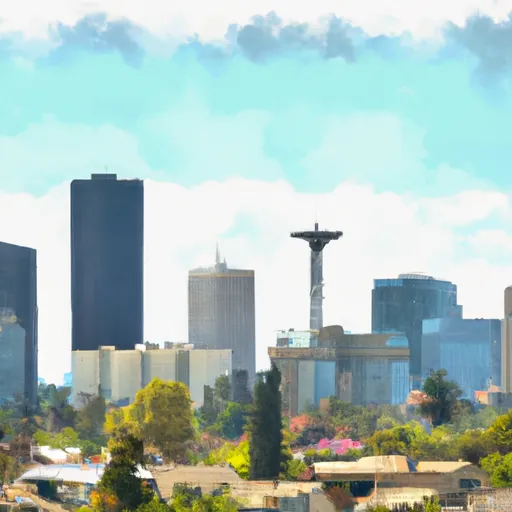-
 Snoflo Premium
Snoflo Premium
Get unlimited access to all our content
With no Ad interruptions! - Start Your Free Trial Login with existing account
Universal-City
Eden Index
Climate
9.4
•
Recreation
4.2
•
Community
3.7
•
Safeguard
6.2/10

Universal City is a vibrant neighborhood located in the San Fernando Valley, California. The climate in Universal City is typically Mediterranean, characterized by warm, dry summers and mild, wet winters. Summers are pleasant with average temperatures ranging from 70 to 90 degrees Fahrenheit, while winter temperatures average around 50 to 70 degrees Fahrenheit.
Hydrologically, Universal City lies in close proximity to the Los Angeles River watershed, which feeds into the Pacific Ocean. The area is also influenced by the nearby Santa Monica Mountains, which supply fresh water and contribute to the local hydrology.
Outdoor recreation opportunities abound in Universal City and its surrounding areas. Nearby Griffith Park offers a multitude of activities, including hiking trails, biking paths, and picnicking spots. The park is also home to the Griffith Observatory, where visitors can stargaze and learn about astronomy. Additionally, Universal City residents and visitors can enjoy golfing at the nearby Woodley Lakes Golf Course or explore the numerous beaches along the Pacific coastline, such as Santa Monica Beach or Venice Beach.
In conclusion, Universal City, California, offers a pleasant Mediterranean climate, is situated near the Los Angeles River watershed, and provides a variety of outdoor recreation opportunities.
What is the Eden Index?
The Snoflo Eden Index serves as a comprehensive rating system for regions, evaluating their desirability through a holistic assessment of climate health, outdoor recreation opportunities, and natural disaster risk, acknowledging the profound impact of these factors on livability and well-being.
Climate Health Indicator (CHI): 9.4
Universal-City receives approximately
455mm of rain per year,
with humidity levels near 58%
and air temperatures averaging around
19°C.
Universal-City has a plant hardyness factor of
10, meaning
plants and agriculture in this region tend to thrive here all year round.
By considering the ideal temperature range, reliable water supplies, clean air, and stable seasonal rain or snowpacks, the Climate Health Indicator (CHI) underscores the significance of a healthy climate as the foundation for quality living.
A healthy climate is paramount for ensuring a high quality of life and livability in a region, fostering both physical well-being and environmental harmony. This can be characterized by ideal temperatures, reliable access to water supplies, clean air, and consistent seasonal rain or snowpacks.
Weather Forecast
Streamflow Conditions
Ventura-San Gabriel Coastal
Area Rivers
Ventura-San Gabriel Coastal
Snowpack Depths
Ventura-San Gabriel Coastal
Reservoir Storage Capacity
Ventura-San Gabriel Coastal
Groundwater Levels
Recreational Opportunity Index (ROI): 4.2
The Recreational Opportunity Index (ROI) recognizes the value of outdoor recreational options, such as parks, hiking trails, camping sites, and fishing spots, while acknowledging that climate plays a pivotal role in ensuring the comfort and consistency of these experiences.
Access to outdoor recreational opportunities, encompassing activities such as parks, hiking, camping, and fishing, is crucial for overall well-being, and the climate plays a pivotal role in enabling and enhancing these experiences, ensuring that individuals can engage in nature-based activities comfortably and consistently.
Camping Areas
| Campground | Campsites | Reservations | Toilets | Showers | Elevation |
|---|---|---|---|---|---|
| Streamside | 9 | 2,364 ft | |||
| Gould Mesa | 7 | 1,418 ft | |||
| Millard | 5 | 1,980 ft | |||
| Dockweiler Beach RV | 117 | 45 ft | |||
| Oakwilde | 7 | 1,831 ft | |||
| Messenger Flats | 10 | 5,793 ft |
Nearby Fishing
Catastrophe Safeguard Index (CSI):
The Catastrophe Safeguard Index (CSI) recognizes that natural disaster risk, encompassing floods, fires, hurricanes, and tornadoes, can drastically affect safety and the overall appeal of an area.
The level of natural disaster risk in a region significantly affects safety and the overall livability, with climate change amplifying these risks by potentially increasing the frequency and intensity of events like floods, fires, hurricanes, and tornadoes, thereby posing substantial challenges to community resilience and well-being.
Community Resilience Indicator (CRI): 3.7
The Community Resilience Indicator (CRI) recognizes that education, healthcare, and socioeconomics are crucial to the well-being of a region. The CRI acknowledges the profound impact of these elements on residents' overall quality of life. By evaluating educational resources, healthcare accessibility, and economic inclusivity, the index captures the essential aspects that contribute to a thriving community, fostering resident satisfaction, equity, and social cohesion.

